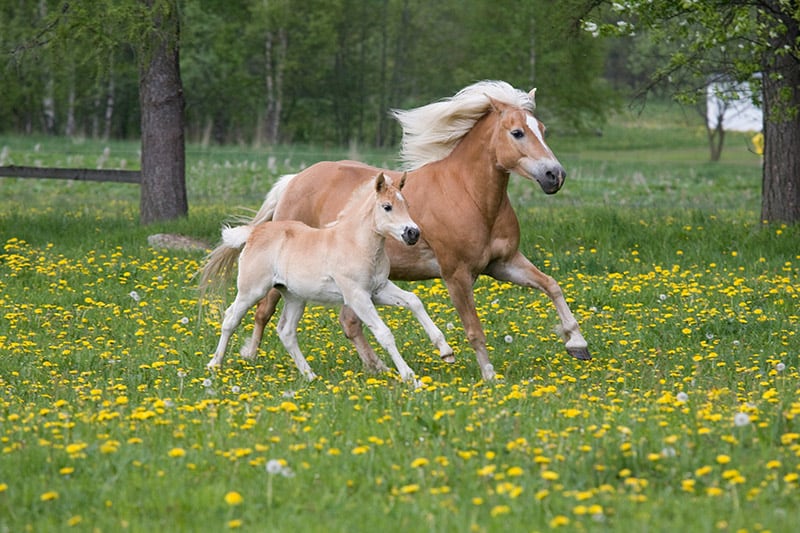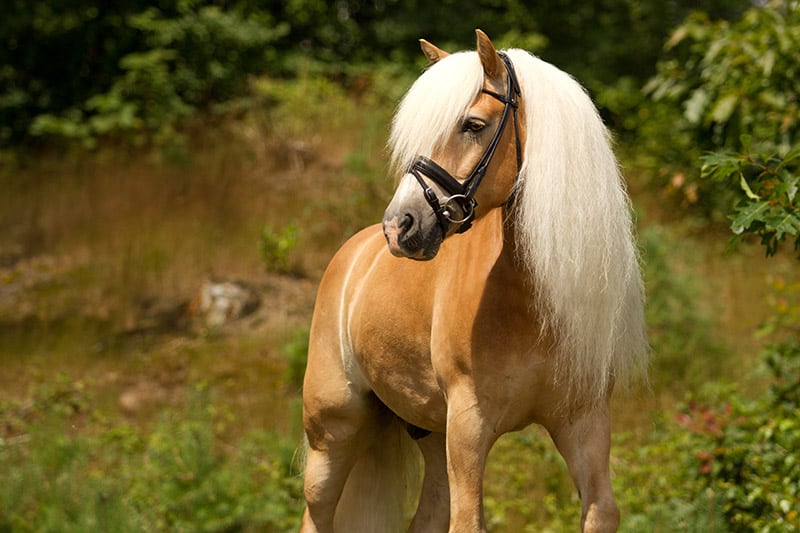With a heritage traced to the Alpine mountain ponies, the Haflinger is very hardy and strong, but also sweet tempered!
The Haflinger is a small, sturdy chestnut-colored horse descended from the Tyrolean ponies of Austria and northern Italy. It is also known as the Avelignese. Though they are quite small, standing between 13 to 15 hands high, these horses are not ponies.
The exact origin of the Haflinger is unknown, but their heritage includes ponies from the Tyrolean mountains of Austria. All Haflingers trace their ancestry back to the foundation stallion, 249 Folie, born in 1874. Powerful and hardy, these hard-working horses were used by farmers for pulling, as pack horses, and for transportation. The name Haflinger comes from the village of Halfling, in a region that now belongs to Italy, where Folie was born.
With a heritage of tough hard-working horses, the Haflingers are strong and hardy. These attractive multi-talented horses are known for their longevity and excellent disposition. The Haflinger horse is very people oriented with a docile and friendly nature. Intelligent and sensible, they are quick learners and a ‘jack of all trades’. They have a place in all disciplines though are not necessarily specialized in any. They are used for trail riding and endurance, as well as for therapeutic riding. They are successful in low to mid level dressage, jumping, and vaulting. This breed is also widely used in driving and for working and pulling farm equipment.
Until 1945 the Haflinger was primarily distributed in the region of the central Alps. It has since become a worldwide breed bred in more than sixty countries. The American Haflinger registry in Akron Ohio is one of 22 national registries making up a confederation overseen by the World Haflinger Federation. There are currently over 20,000 Haflingers registered in the U.S.
Scientific Classification
| Kingdom: | Animalia |
| Phylum: | Chordata |
| Class: | Mammalia |
| Order: | Perissodactyla |
| Family: | Equidae |
| Genus: | Equus |
| Species: | caballus |
Horse Breeds
The Haflinger Horses are a light horse breed and one of the warmblood breeds from Europe. Light horse breeds generally weigh under 1,500 pounds. They are typically used as riding horses for leisure and trail riding. Being agile and swift, many are also used on the racetrack, in the show ring, and for work on the ranch.
Light horses are grouped in a couple of different ways, one being the continent or country where they originated from. They are also grouped according to training, classified as either a stock type, hunter type, saddle type, or ‘other’. A body type is generally attributed to each class, with the ‘other’ classification being a bit of an odd ball. It includes those that are color breeds or those that may fit a body type of one of the training classes, but not be used for that type of training. In some cases the ‘other’ types can also include those that may fit into more than one of the type groups.
The horse class the Haflinger Horse fits into is the ‘other’ type class. It is a ‘jack of all trades’, and while not specialized in any one area, it is successful in many disciplines.

Horse Backgrounds
Although the exact origin of the Haflinger is unknown, it is believed that they descend from a stallion sent by sent to Margrave Louis of Brandenburg by his father, the Holy Roman Emperor, when he married Princess Margarete Maultasch of Tyrol in 1342.
Regardless of the previous origins, however, all Haflingers trace their ancestry back to Folie. Folie’s Dam was a nicely refined native Tyrolean mare. His sire was the Arabian Stallion El-Bedavi XXII, whose great grandfather was imported into Austria in the nineteenth century.
Only seven stallion bloodlines, designated A, B, M, N, S, ST and W are allowed for the Haflinger to be considered purebred. The relatively small gene pool has resulted in a very specific physical appearance, and all Haflingers are chestnut or sorrel in color, with pretty, refined heads, long manes, and muscular hindquarters.
Working on the small, steep mountain farms in the Alps, these hardworking horses have been affectionately referred to as the “tractor of the Alps”. Living in close quarters with their owners, often in the lower levels of the house to take advantage of their body heat, they have developed to be personable, sensible and affectionate.
Description
Haflingers range from pale chestnut to dark liver chestnut with a pale or flaxen mane and tail. Color impurities are undesirable. Leg markings are also undesirable; however moderate head markings are allowed and encouraged.
The desired size is from 54 to 60 inches, or 13.2 to 15 hands high. Haflingers should have a lean, elegant head with expressive eyes, a well formed neck, supple midsection, and a medium sized croup. The limbs should be well defined with good range of mobility in the joints. They should have the look of an all around athlete with a harmonious body structure.
The gaits should be clear and rhythmic. The walk should be a clear four beats, the trot two beats, and the canter three beats. Some knee action is desirable, and the trot and canter should show natural suspension with uphill balance.
Horse Care and Feeding
Haflingers do not require a large stall space if they are exercised regularly. They have a history of living in close quarters with humans, and are used to working hard to earn their keep. They become easily bored if not challenged in their work, and distractions should be provided to enrich their environment. They enjoy “stall balls”, “pony pops” or some other type of equine toy. They are highly social and enjoy the company of other horses.

Horse Training and Activities
The Haflinger should do well in most disciplines. It is truly a “jack of all trades”, while not necessarily specializing in any. Successful in low to mid level dressage, jumping, and vaulting, this breed is also widely used in driving, working and pulling farm equipment. He is a dependable trail or endurance horse and his cleverness and quickness also make him suited to many western disciplines.
Common Health Problems
These robust horses are easy keepers and have no special health risks. Because strict attention is paid to the breeding of these horses, flaws causing unsoundness are highly discouraged. “Pigeon toed, splay footed, knock-kneed or bow legged front legs, narrow or wide at the hock” are highly undesirable traits and horses exhibiting these are discouraged from breeding. As a result, the Haflinger is usually a strong, sound and healthy.
Availability
The Haflinger is available from breeders throughout the country. Though once bred only in the the region of the central Alps, it has since become a worldwide breed bred in more than sixty countries.
Featured Image Credit: Zuzule, Shutterstock
